Cross-Cultural Management: Singapore and Norway Training Course Report
VerifiedAdded on 2022/11/28
|13
|3545
|480
Report
AI Summary
This report provides a comparative analysis of the business cultures of Singapore and Norway, focusing on key differences and their implications for global management. It examines language, networking, and gift-giving practices, as well as organizational structures and communication styles. The report utilizes Hofstede's cultural dimensions to highlight variances in power distance, individualism, masculinity, uncertainty avoidance, and long-term orientation, along with Hall's cultural factors to further compare the two countries. Challenges arising from these cultural differences are identified, and recommendations for cross-cultural training are offered. The training focuses on cultural awareness, language acquisition, and simulation exercises to prepare managers for foreign assignments. This report is a valuable resource for understanding and navigating cross-cultural complexities in international business, particularly in the context of preparing managers for assignments in Singapore and Norway.
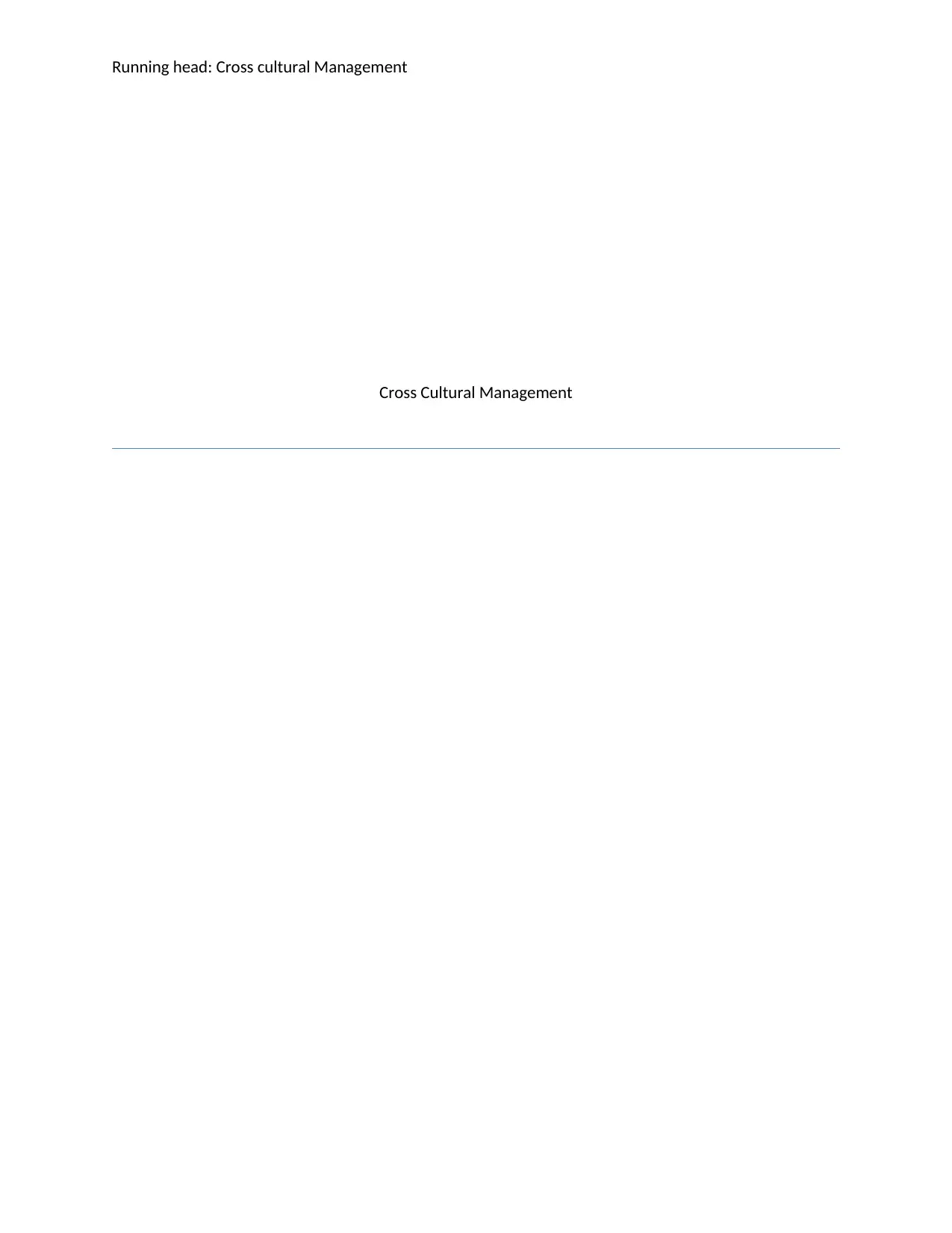
Running head: Cross cultural Management
Cross Cultural Management
Cross Cultural Management
Paraphrase This Document
Need a fresh take? Get an instant paraphrase of this document with our AI Paraphraser
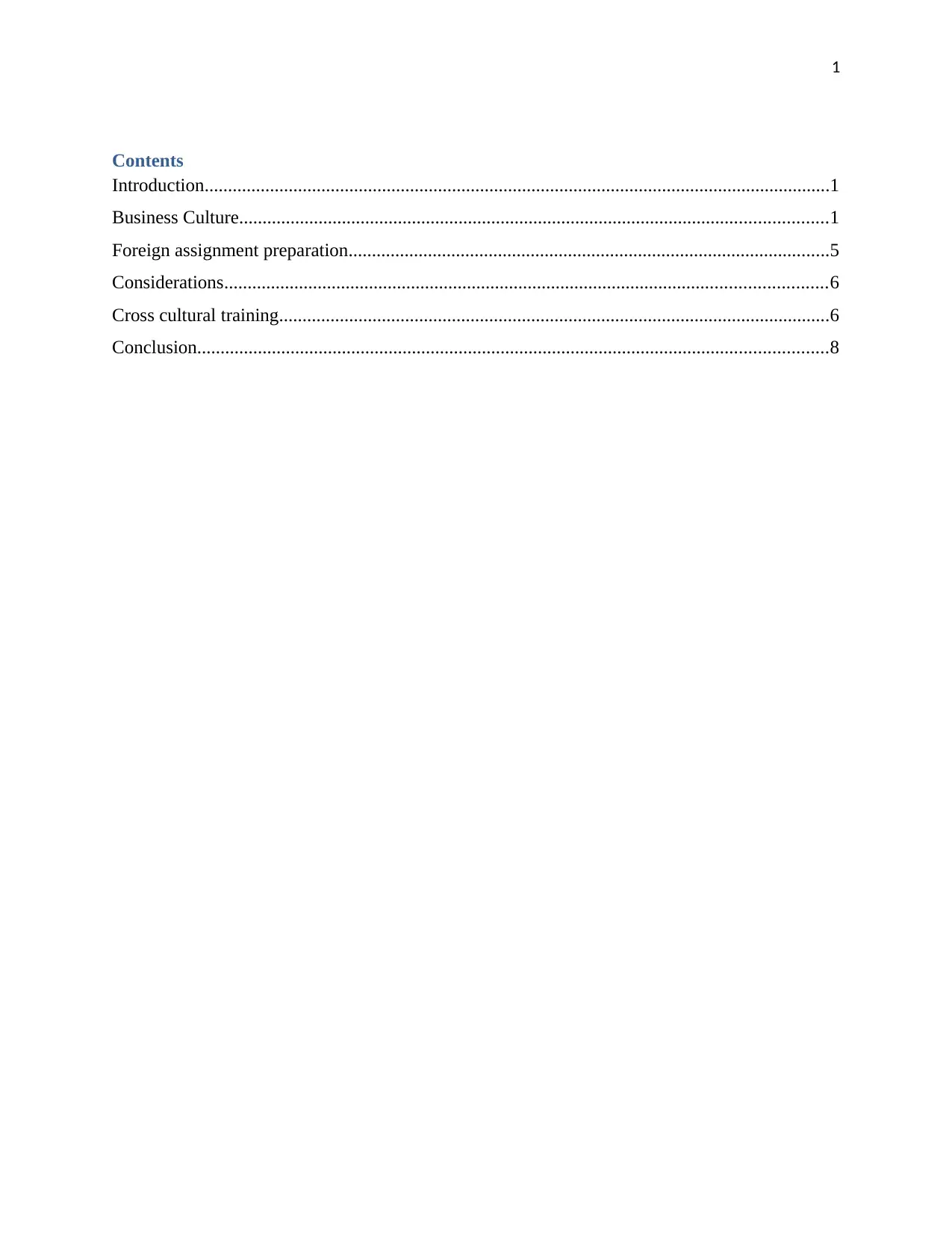
1
Contents
Introduction......................................................................................................................................1
Business Culture..............................................................................................................................1
Foreign assignment preparation.......................................................................................................5
Considerations.................................................................................................................................6
Cross cultural training......................................................................................................................6
Conclusion.......................................................................................................................................8
Contents
Introduction......................................................................................................................................1
Business Culture..............................................................................................................................1
Foreign assignment preparation.......................................................................................................5
Considerations.................................................................................................................................6
Cross cultural training......................................................................................................................6
Conclusion.......................................................................................................................................8
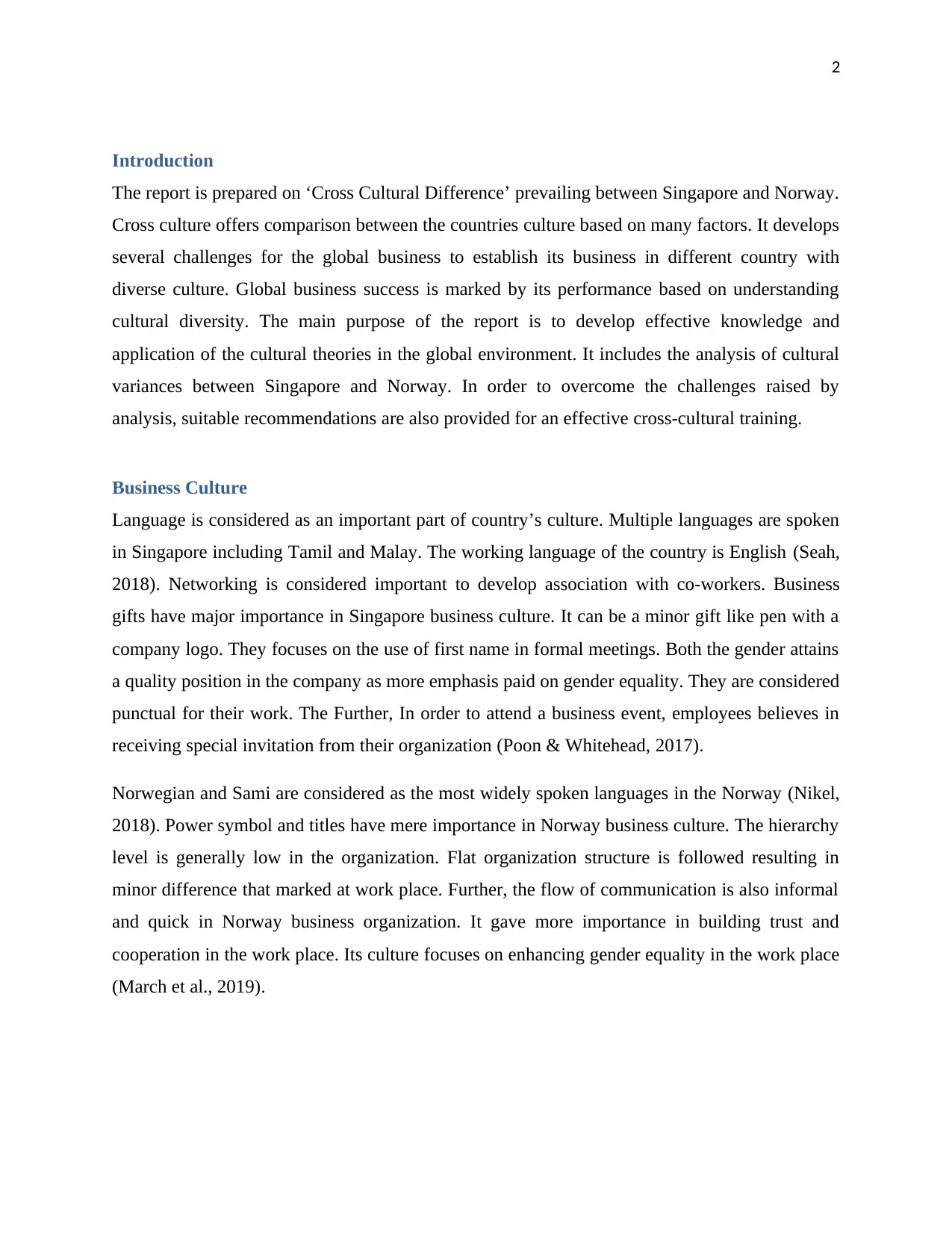
2
Introduction
The report is prepared on ‘Cross Cultural Difference’ prevailing between Singapore and Norway.
Cross culture offers comparison between the countries culture based on many factors. It develops
several challenges for the global business to establish its business in different country with
diverse culture. Global business success is marked by its performance based on understanding
cultural diversity. The main purpose of the report is to develop effective knowledge and
application of the cultural theories in the global environment. It includes the analysis of cultural
variances between Singapore and Norway. In order to overcome the challenges raised by
analysis, suitable recommendations are also provided for an effective cross-cultural training.
Business Culture
Language is considered as an important part of country’s culture. Multiple languages are spoken
in Singapore including Tamil and Malay. The working language of the country is English (Seah,
2018). Networking is considered important to develop association with co-workers. Business
gifts have major importance in Singapore business culture. It can be a minor gift like pen with a
company logo. They focuses on the use of first name in formal meetings. Both the gender attains
a quality position in the company as more emphasis paid on gender equality. They are considered
punctual for their work. The Further, In order to attend a business event, employees believes in
receiving special invitation from their organization (Poon & Whitehead, 2017).
Norwegian and Sami are considered as the most widely spoken languages in the Norway (Nikel,
2018). Power symbol and titles have mere importance in Norway business culture. The hierarchy
level is generally low in the organization. Flat organization structure is followed resulting in
minor difference that marked at work place. Further, the flow of communication is also informal
and quick in Norway business organization. It gave more importance in building trust and
cooperation in the work place. Its culture focuses on enhancing gender equality in the work place
(March et al., 2019).
Introduction
The report is prepared on ‘Cross Cultural Difference’ prevailing between Singapore and Norway.
Cross culture offers comparison between the countries culture based on many factors. It develops
several challenges for the global business to establish its business in different country with
diverse culture. Global business success is marked by its performance based on understanding
cultural diversity. The main purpose of the report is to develop effective knowledge and
application of the cultural theories in the global environment. It includes the analysis of cultural
variances between Singapore and Norway. In order to overcome the challenges raised by
analysis, suitable recommendations are also provided for an effective cross-cultural training.
Business Culture
Language is considered as an important part of country’s culture. Multiple languages are spoken
in Singapore including Tamil and Malay. The working language of the country is English (Seah,
2018). Networking is considered important to develop association with co-workers. Business
gifts have major importance in Singapore business culture. It can be a minor gift like pen with a
company logo. They focuses on the use of first name in formal meetings. Both the gender attains
a quality position in the company as more emphasis paid on gender equality. They are considered
punctual for their work. The Further, In order to attend a business event, employees believes in
receiving special invitation from their organization (Poon & Whitehead, 2017).
Norwegian and Sami are considered as the most widely spoken languages in the Norway (Nikel,
2018). Power symbol and titles have mere importance in Norway business culture. The hierarchy
level is generally low in the organization. Flat organization structure is followed resulting in
minor difference that marked at work place. Further, the flow of communication is also informal
and quick in Norway business organization. It gave more importance in building trust and
cooperation in the work place. Its culture focuses on enhancing gender equality in the work place
(March et al., 2019).
⊘ This is a preview!⊘
Do you want full access?
Subscribe today to unlock all pages.

Trusted by 1+ million students worldwide
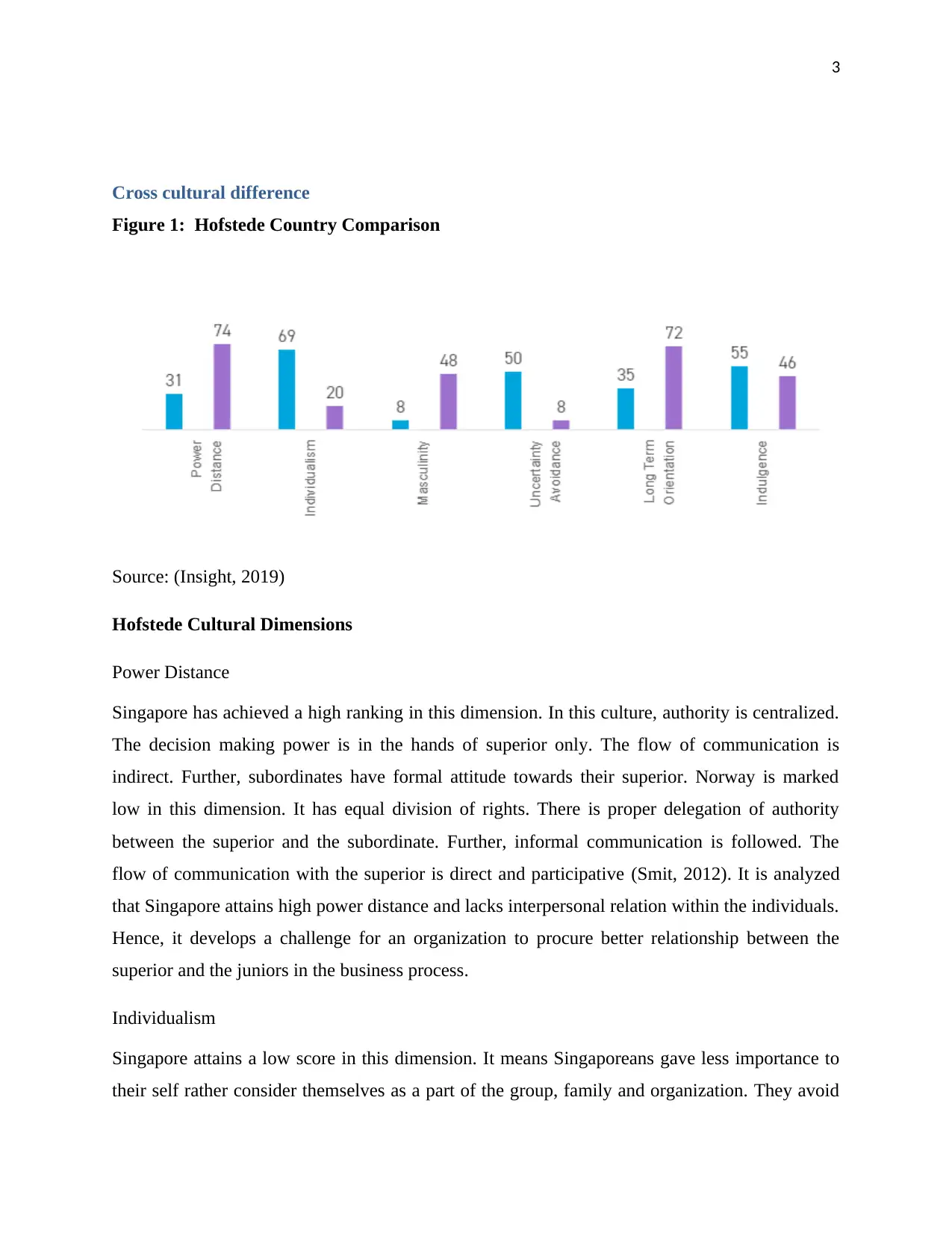
3
Cross cultural difference
Figure 1: Hofstede Country Comparison
Source: (Insight, 2019)
Hofstede Cultural Dimensions
Power Distance
Singapore has achieved a high ranking in this dimension. In this culture, authority is centralized.
The decision making power is in the hands of superior only. The flow of communication is
indirect. Further, subordinates have formal attitude towards their superior. Norway is marked
low in this dimension. It has equal division of rights. There is proper delegation of authority
between the superior and the subordinate. Further, informal communication is followed. The
flow of communication with the superior is direct and participative (Smit, 2012). It is analyzed
that Singapore attains high power distance and lacks interpersonal relation within the individuals.
Hence, it develops a challenge for an organization to procure better relationship between the
superior and the juniors in the business process.
Individualism
Singapore attains a low score in this dimension. It means Singaporeans gave less importance to
their self rather consider themselves as a part of the group, family and organization. They avoid
Cross cultural difference
Figure 1: Hofstede Country Comparison
Source: (Insight, 2019)
Hofstede Cultural Dimensions
Power Distance
Singapore has achieved a high ranking in this dimension. In this culture, authority is centralized.
The decision making power is in the hands of superior only. The flow of communication is
indirect. Further, subordinates have formal attitude towards their superior. Norway is marked
low in this dimension. It has equal division of rights. There is proper delegation of authority
between the superior and the subordinate. Further, informal communication is followed. The
flow of communication with the superior is direct and participative (Smit, 2012). It is analyzed
that Singapore attains high power distance and lacks interpersonal relation within the individuals.
Hence, it develops a challenge for an organization to procure better relationship between the
superior and the juniors in the business process.
Individualism
Singapore attains a low score in this dimension. It means Singaporeans gave less importance to
their self rather consider themselves as a part of the group, family and organization. They avoid
Paraphrase This Document
Need a fresh take? Get an instant paraphrase of this document with our AI Paraphraser
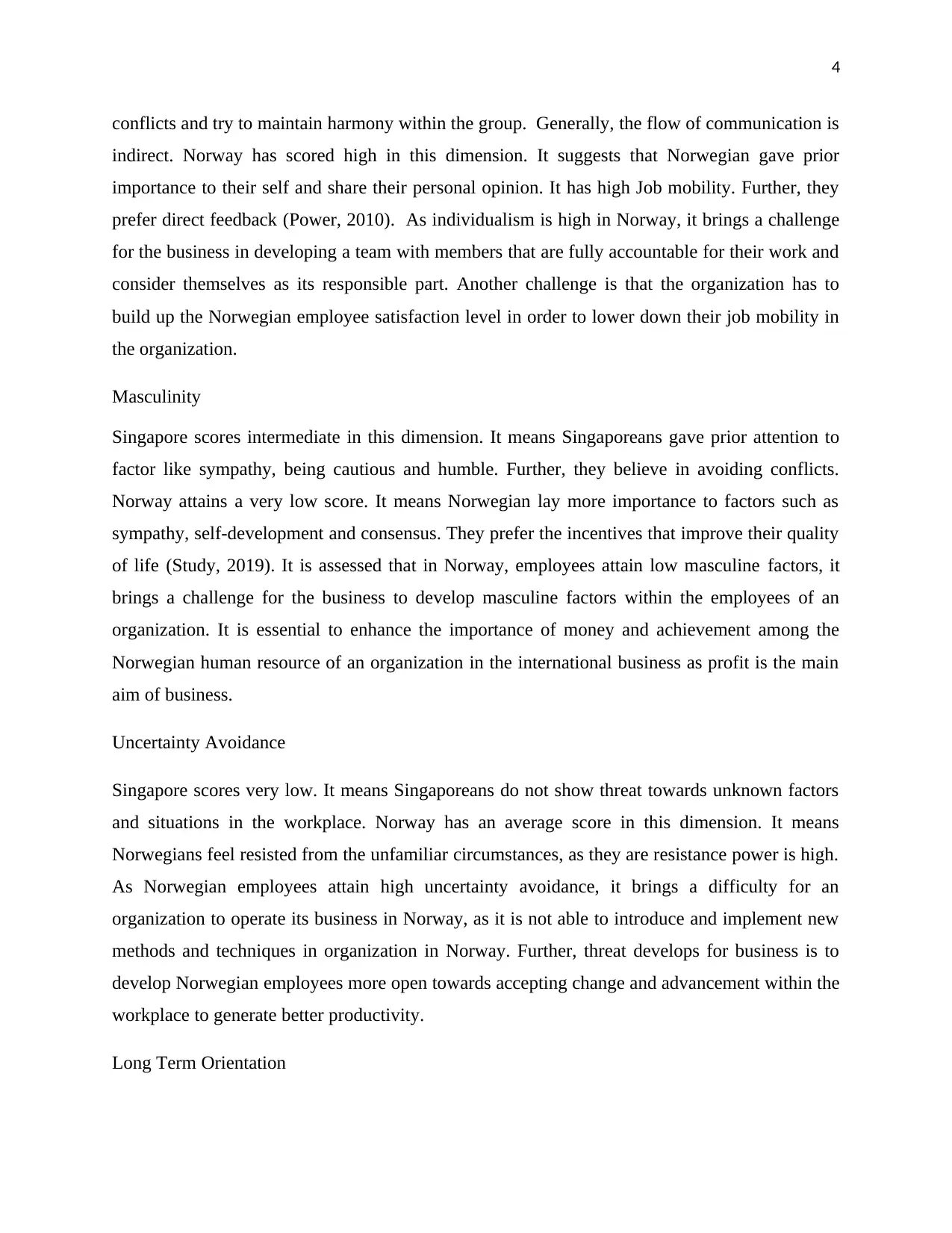
4
conflicts and try to maintain harmony within the group. Generally, the flow of communication is
indirect. Norway has scored high in this dimension. It suggests that Norwegian gave prior
importance to their self and share their personal opinion. It has high Job mobility. Further, they
prefer direct feedback (Power, 2010). As individualism is high in Norway, it brings a challenge
for the business in developing a team with members that are fully accountable for their work and
consider themselves as its responsible part. Another challenge is that the organization has to
build up the Norwegian employee satisfaction level in order to lower down their job mobility in
the organization.
Masculinity
Singapore scores intermediate in this dimension. It means Singaporeans gave prior attention to
factor like sympathy, being cautious and humble. Further, they believe in avoiding conflicts.
Norway attains a very low score. It means Norwegian lay more importance to factors such as
sympathy, self-development and consensus. They prefer the incentives that improve their quality
of life (Study, 2019). It is assessed that in Norway, employees attain low masculine factors, it
brings a challenge for the business to develop masculine factors within the employees of an
organization. It is essential to enhance the importance of money and achievement among the
Norwegian human resource of an organization in the international business as profit is the main
aim of business.
Uncertainty Avoidance
Singapore scores very low. It means Singaporeans do not show threat towards unknown factors
and situations in the workplace. Norway has an average score in this dimension. It means
Norwegians feel resisted from the unfamiliar circumstances, as they are resistance power is high.
As Norwegian employees attain high uncertainty avoidance, it brings a difficulty for an
organization to operate its business in Norway, as it is not able to introduce and implement new
methods and techniques in organization in Norway. Further, threat develops for business is to
develop Norwegian employees more open towards accepting change and advancement within the
workplace to generate better productivity.
Long Term Orientation
conflicts and try to maintain harmony within the group. Generally, the flow of communication is
indirect. Norway has scored high in this dimension. It suggests that Norwegian gave prior
importance to their self and share their personal opinion. It has high Job mobility. Further, they
prefer direct feedback (Power, 2010). As individualism is high in Norway, it brings a challenge
for the business in developing a team with members that are fully accountable for their work and
consider themselves as its responsible part. Another challenge is that the organization has to
build up the Norwegian employee satisfaction level in order to lower down their job mobility in
the organization.
Masculinity
Singapore scores intermediate in this dimension. It means Singaporeans gave prior attention to
factor like sympathy, being cautious and humble. Further, they believe in avoiding conflicts.
Norway attains a very low score. It means Norwegian lay more importance to factors such as
sympathy, self-development and consensus. They prefer the incentives that improve their quality
of life (Study, 2019). It is assessed that in Norway, employees attain low masculine factors, it
brings a challenge for the business to develop masculine factors within the employees of an
organization. It is essential to enhance the importance of money and achievement among the
Norwegian human resource of an organization in the international business as profit is the main
aim of business.
Uncertainty Avoidance
Singapore scores very low. It means Singaporeans do not show threat towards unknown factors
and situations in the workplace. Norway has an average score in this dimension. It means
Norwegians feel resisted from the unfamiliar circumstances, as they are resistance power is high.
As Norwegian employees attain high uncertainty avoidance, it brings a difficulty for an
organization to operate its business in Norway, as it is not able to introduce and implement new
methods and techniques in organization in Norway. Further, threat develops for business is to
develop Norwegian employees more open towards accepting change and advancement within the
workplace to generate better productivity.
Long Term Orientation
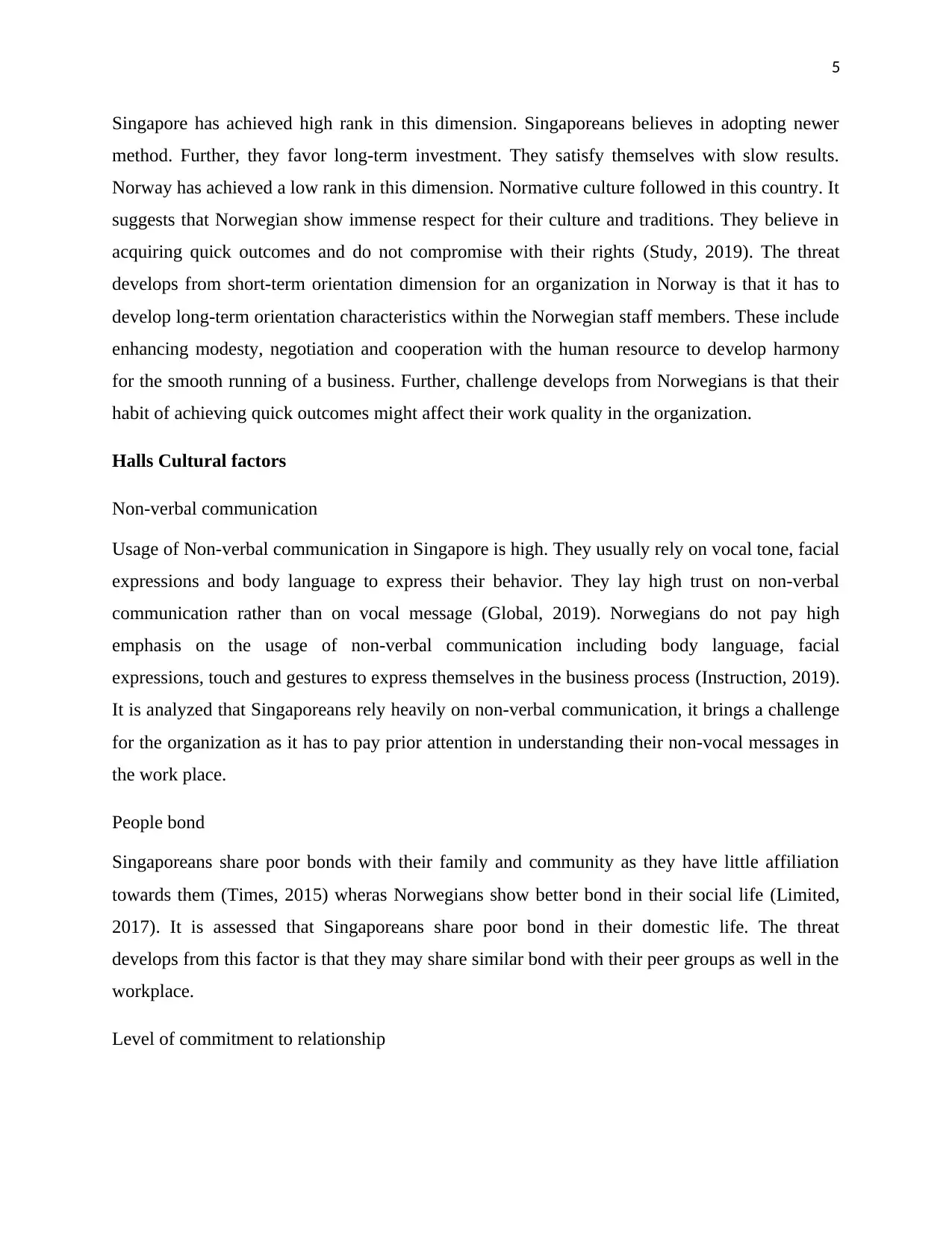
5
Singapore has achieved high rank in this dimension. Singaporeans believes in adopting newer
method. Further, they favor long-term investment. They satisfy themselves with slow results.
Norway has achieved a low rank in this dimension. Normative culture followed in this country. It
suggests that Norwegian show immense respect for their culture and traditions. They believe in
acquiring quick outcomes and do not compromise with their rights (Study, 2019). The threat
develops from short-term orientation dimension for an organization in Norway is that it has to
develop long-term orientation characteristics within the Norwegian staff members. These include
enhancing modesty, negotiation and cooperation with the human resource to develop harmony
for the smooth running of a business. Further, challenge develops from Norwegians is that their
habit of achieving quick outcomes might affect their work quality in the organization.
Halls Cultural factors
Non-verbal communication
Usage of Non-verbal communication in Singapore is high. They usually rely on vocal tone, facial
expressions and body language to express their behavior. They lay high trust on non-verbal
communication rather than on vocal message (Global, 2019). Norwegians do not pay high
emphasis on the usage of non-verbal communication including body language, facial
expressions, touch and gestures to express themselves in the business process (Instruction, 2019).
It is analyzed that Singaporeans rely heavily on non-verbal communication, it brings a challenge
for the organization as it has to pay prior attention in understanding their non-vocal messages in
the work place.
People bond
Singaporeans share poor bonds with their family and community as they have little affiliation
towards them (Times, 2015) wheras Norwegians show better bond in their social life (Limited,
2017). It is assessed that Singaporeans share poor bond in their domestic life. The threat
develops from this factor is that they may share similar bond with their peer groups as well in the
workplace.
Level of commitment to relationship
Singapore has achieved high rank in this dimension. Singaporeans believes in adopting newer
method. Further, they favor long-term investment. They satisfy themselves with slow results.
Norway has achieved a low rank in this dimension. Normative culture followed in this country. It
suggests that Norwegian show immense respect for their culture and traditions. They believe in
acquiring quick outcomes and do not compromise with their rights (Study, 2019). The threat
develops from short-term orientation dimension for an organization in Norway is that it has to
develop long-term orientation characteristics within the Norwegian staff members. These include
enhancing modesty, negotiation and cooperation with the human resource to develop harmony
for the smooth running of a business. Further, challenge develops from Norwegians is that their
habit of achieving quick outcomes might affect their work quality in the organization.
Halls Cultural factors
Non-verbal communication
Usage of Non-verbal communication in Singapore is high. They usually rely on vocal tone, facial
expressions and body language to express their behavior. They lay high trust on non-verbal
communication rather than on vocal message (Global, 2019). Norwegians do not pay high
emphasis on the usage of non-verbal communication including body language, facial
expressions, touch and gestures to express themselves in the business process (Instruction, 2019).
It is analyzed that Singaporeans rely heavily on non-verbal communication, it brings a challenge
for the organization as it has to pay prior attention in understanding their non-vocal messages in
the work place.
People bond
Singaporeans share poor bonds with their family and community as they have little affiliation
towards them (Times, 2015) wheras Norwegians show better bond in their social life (Limited,
2017). It is assessed that Singaporeans share poor bond in their domestic life. The threat
develops from this factor is that they may share similar bond with their peer groups as well in the
workplace.
Level of commitment to relationship
⊘ This is a preview!⊘
Do you want full access?
Subscribe today to unlock all pages.

Trusted by 1+ million students worldwide
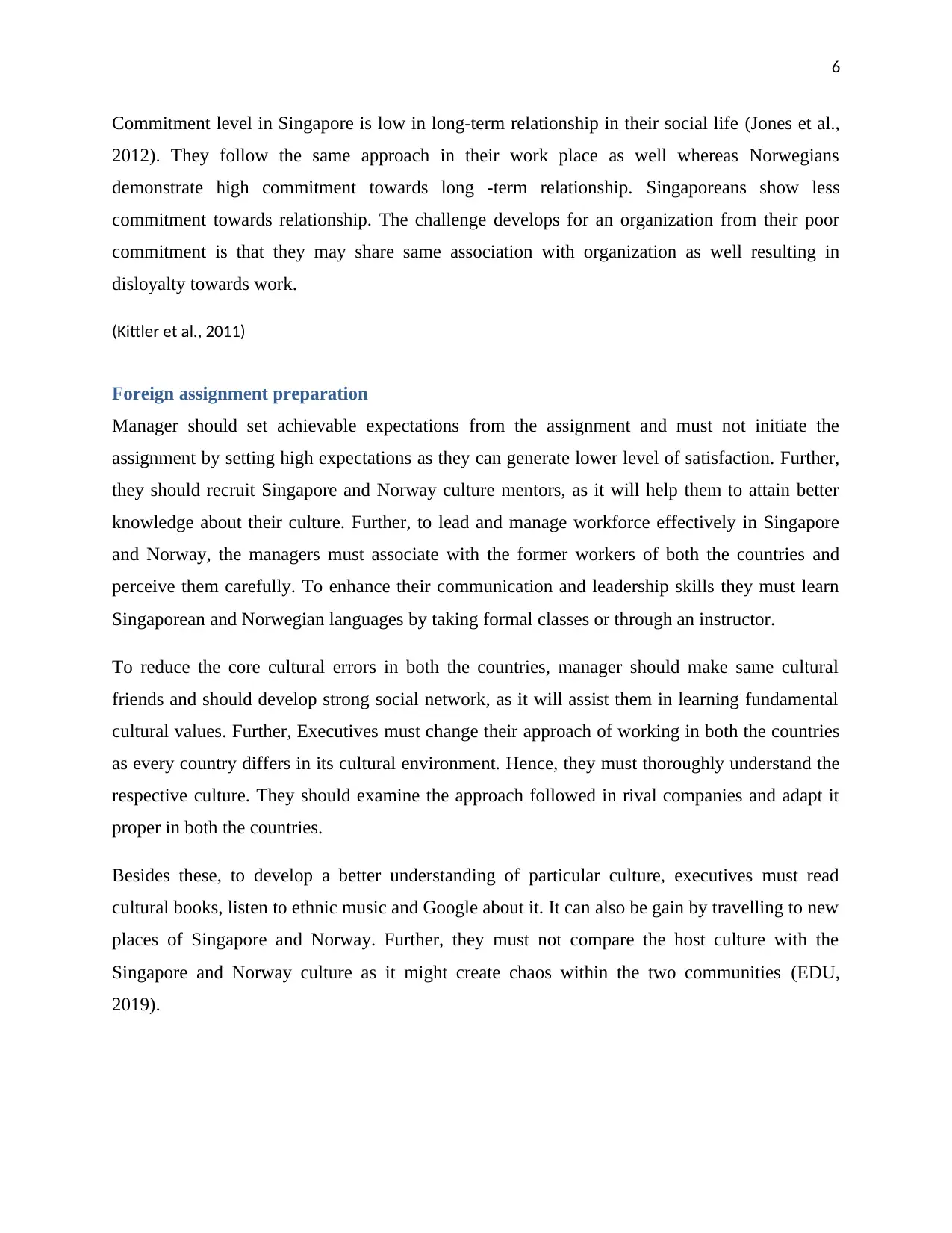
6
Commitment level in Singapore is low in long-term relationship in their social life (Jones et al.,
2012). They follow the same approach in their work place as well whereas Norwegians
demonstrate high commitment towards long -term relationship. Singaporeans show less
commitment towards relationship. The challenge develops for an organization from their poor
commitment is that they may share same association with organization as well resulting in
disloyalty towards work.
(Kittler et al., 2011)
Foreign assignment preparation
Manager should set achievable expectations from the assignment and must not initiate the
assignment by setting high expectations as they can generate lower level of satisfaction. Further,
they should recruit Singapore and Norway culture mentors, as it will help them to attain better
knowledge about their culture. Further, to lead and manage workforce effectively in Singapore
and Norway, the managers must associate with the former workers of both the countries and
perceive them carefully. To enhance their communication and leadership skills they must learn
Singaporean and Norwegian languages by taking formal classes or through an instructor.
To reduce the core cultural errors in both the countries, manager should make same cultural
friends and should develop strong social network, as it will assist them in learning fundamental
cultural values. Further, Executives must change their approach of working in both the countries
as every country differs in its cultural environment. Hence, they must thoroughly understand the
respective culture. They should examine the approach followed in rival companies and adapt it
proper in both the countries.
Besides these, to develop a better understanding of particular culture, executives must read
cultural books, listen to ethnic music and Google about it. It can also be gain by travelling to new
places of Singapore and Norway. Further, they must not compare the host culture with the
Singapore and Norway culture as it might create chaos within the two communities (EDU,
2019).
Commitment level in Singapore is low in long-term relationship in their social life (Jones et al.,
2012). They follow the same approach in their work place as well whereas Norwegians
demonstrate high commitment towards long -term relationship. Singaporeans show less
commitment towards relationship. The challenge develops for an organization from their poor
commitment is that they may share same association with organization as well resulting in
disloyalty towards work.
(Kittler et al., 2011)
Foreign assignment preparation
Manager should set achievable expectations from the assignment and must not initiate the
assignment by setting high expectations as they can generate lower level of satisfaction. Further,
they should recruit Singapore and Norway culture mentors, as it will help them to attain better
knowledge about their culture. Further, to lead and manage workforce effectively in Singapore
and Norway, the managers must associate with the former workers of both the countries and
perceive them carefully. To enhance their communication and leadership skills they must learn
Singaporean and Norwegian languages by taking formal classes or through an instructor.
To reduce the core cultural errors in both the countries, manager should make same cultural
friends and should develop strong social network, as it will assist them in learning fundamental
cultural values. Further, Executives must change their approach of working in both the countries
as every country differs in its cultural environment. Hence, they must thoroughly understand the
respective culture. They should examine the approach followed in rival companies and adapt it
proper in both the countries.
Besides these, to develop a better understanding of particular culture, executives must read
cultural books, listen to ethnic music and Google about it. It can also be gain by travelling to new
places of Singapore and Norway. Further, they must not compare the host culture with the
Singapore and Norway culture as it might create chaos within the two communities (EDU,
2019).
Paraphrase This Document
Need a fresh take? Get an instant paraphrase of this document with our AI Paraphraser
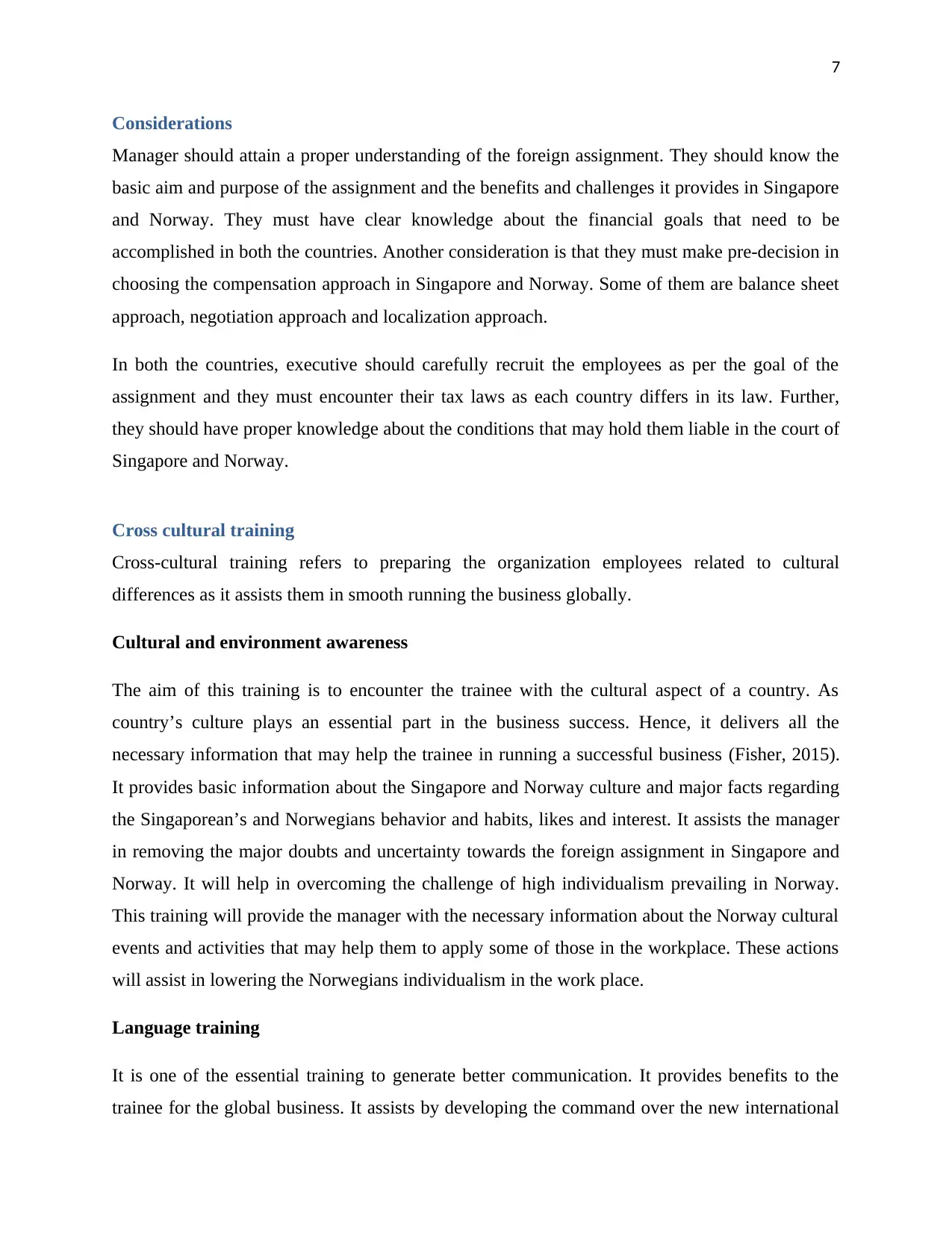
7
Considerations
Manager should attain a proper understanding of the foreign assignment. They should know the
basic aim and purpose of the assignment and the benefits and challenges it provides in Singapore
and Norway. They must have clear knowledge about the financial goals that need to be
accomplished in both the countries. Another consideration is that they must make pre-decision in
choosing the compensation approach in Singapore and Norway. Some of them are balance sheet
approach, negotiation approach and localization approach.
In both the countries, executive should carefully recruit the employees as per the goal of the
assignment and they must encounter their tax laws as each country differs in its law. Further,
they should have proper knowledge about the conditions that may hold them liable in the court of
Singapore and Norway.
Cross cultural training
Cross-cultural training refers to preparing the organization employees related to cultural
differences as it assists them in smooth running the business globally.
Cultural and environment awareness
The aim of this training is to encounter the trainee with the cultural aspect of a country. As
country’s culture plays an essential part in the business success. Hence, it delivers all the
necessary information that may help the trainee in running a successful business (Fisher, 2015).
It provides basic information about the Singapore and Norway culture and major facts regarding
the Singaporean’s and Norwegians behavior and habits, likes and interest. It assists the manager
in removing the major doubts and uncertainty towards the foreign assignment in Singapore and
Norway. It will help in overcoming the challenge of high individualism prevailing in Norway.
This training will provide the manager with the necessary information about the Norway cultural
events and activities that may help them to apply some of those in the workplace. These actions
will assist in lowering the Norwegians individualism in the work place.
Language training
It is one of the essential training to generate better communication. It provides benefits to the
trainee for the global business. It assists by developing the command over the new international
Considerations
Manager should attain a proper understanding of the foreign assignment. They should know the
basic aim and purpose of the assignment and the benefits and challenges it provides in Singapore
and Norway. They must have clear knowledge about the financial goals that need to be
accomplished in both the countries. Another consideration is that they must make pre-decision in
choosing the compensation approach in Singapore and Norway. Some of them are balance sheet
approach, negotiation approach and localization approach.
In both the countries, executive should carefully recruit the employees as per the goal of the
assignment and they must encounter their tax laws as each country differs in its law. Further,
they should have proper knowledge about the conditions that may hold them liable in the court of
Singapore and Norway.
Cross cultural training
Cross-cultural training refers to preparing the organization employees related to cultural
differences as it assists them in smooth running the business globally.
Cultural and environment awareness
The aim of this training is to encounter the trainee with the cultural aspect of a country. As
country’s culture plays an essential part in the business success. Hence, it delivers all the
necessary information that may help the trainee in running a successful business (Fisher, 2015).
It provides basic information about the Singapore and Norway culture and major facts regarding
the Singaporean’s and Norwegians behavior and habits, likes and interest. It assists the manager
in removing the major doubts and uncertainty towards the foreign assignment in Singapore and
Norway. It will help in overcoming the challenge of high individualism prevailing in Norway.
This training will provide the manager with the necessary information about the Norway cultural
events and activities that may help them to apply some of those in the workplace. These actions
will assist in lowering the Norwegians individualism in the work place.
Language training
It is one of the essential training to generate better communication. It provides benefits to the
trainee for the global business. It assists by developing the command over the new international
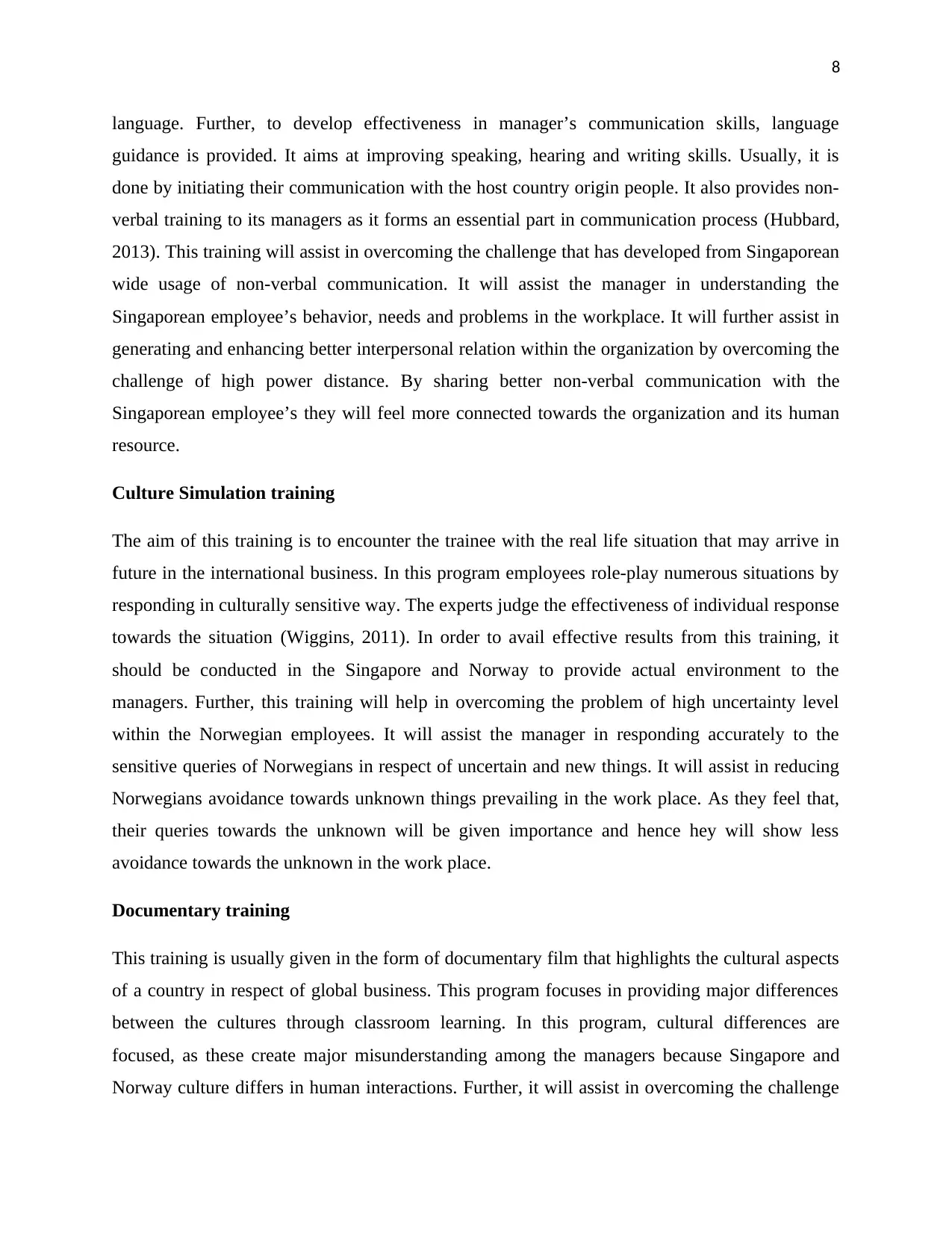
8
language. Further, to develop effectiveness in manager’s communication skills, language
guidance is provided. It aims at improving speaking, hearing and writing skills. Usually, it is
done by initiating their communication with the host country origin people. It also provides non-
verbal training to its managers as it forms an essential part in communication process (Hubbard,
2013). This training will assist in overcoming the challenge that has developed from Singaporean
wide usage of non-verbal communication. It will assist the manager in understanding the
Singaporean employee’s behavior, needs and problems in the workplace. It will further assist in
generating and enhancing better interpersonal relation within the organization by overcoming the
challenge of high power distance. By sharing better non-verbal communication with the
Singaporean employee’s they will feel more connected towards the organization and its human
resource.
Culture Simulation training
The aim of this training is to encounter the trainee with the real life situation that may arrive in
future in the international business. In this program employees role-play numerous situations by
responding in culturally sensitive way. The experts judge the effectiveness of individual response
towards the situation (Wiggins, 2011). In order to avail effective results from this training, it
should be conducted in the Singapore and Norway to provide actual environment to the
managers. Further, this training will help in overcoming the problem of high uncertainty level
within the Norwegian employees. It will assist the manager in responding accurately to the
sensitive queries of Norwegians in respect of uncertain and new things. It will assist in reducing
Norwegians avoidance towards unknown things prevailing in the work place. As they feel that,
their queries towards the unknown will be given importance and hence hey will show less
avoidance towards the unknown in the work place.
Documentary training
This training is usually given in the form of documentary film that highlights the cultural aspects
of a country in respect of global business. This program focuses in providing major differences
between the cultures through classroom learning. In this program, cultural differences are
focused, as these create major misunderstanding among the managers because Singapore and
Norway culture differs in human interactions. Further, it will assist in overcoming the challenge
language. Further, to develop effectiveness in manager’s communication skills, language
guidance is provided. It aims at improving speaking, hearing and writing skills. Usually, it is
done by initiating their communication with the host country origin people. It also provides non-
verbal training to its managers as it forms an essential part in communication process (Hubbard,
2013). This training will assist in overcoming the challenge that has developed from Singaporean
wide usage of non-verbal communication. It will assist the manager in understanding the
Singaporean employee’s behavior, needs and problems in the workplace. It will further assist in
generating and enhancing better interpersonal relation within the organization by overcoming the
challenge of high power distance. By sharing better non-verbal communication with the
Singaporean employee’s they will feel more connected towards the organization and its human
resource.
Culture Simulation training
The aim of this training is to encounter the trainee with the real life situation that may arrive in
future in the international business. In this program employees role-play numerous situations by
responding in culturally sensitive way. The experts judge the effectiveness of individual response
towards the situation (Wiggins, 2011). In order to avail effective results from this training, it
should be conducted in the Singapore and Norway to provide actual environment to the
managers. Further, this training will help in overcoming the problem of high uncertainty level
within the Norwegian employees. It will assist the manager in responding accurately to the
sensitive queries of Norwegians in respect of uncertain and new things. It will assist in reducing
Norwegians avoidance towards unknown things prevailing in the work place. As they feel that,
their queries towards the unknown will be given importance and hence hey will show less
avoidance towards the unknown in the work place.
Documentary training
This training is usually given in the form of documentary film that highlights the cultural aspects
of a country in respect of global business. This program focuses in providing major differences
between the cultures through classroom learning. In this program, cultural differences are
focused, as these create major misunderstanding among the managers because Singapore and
Norway culture differs in human interactions. Further, it will assist in overcoming the challenge
⊘ This is a preview!⊘
Do you want full access?
Subscribe today to unlock all pages.

Trusted by 1+ million students worldwide
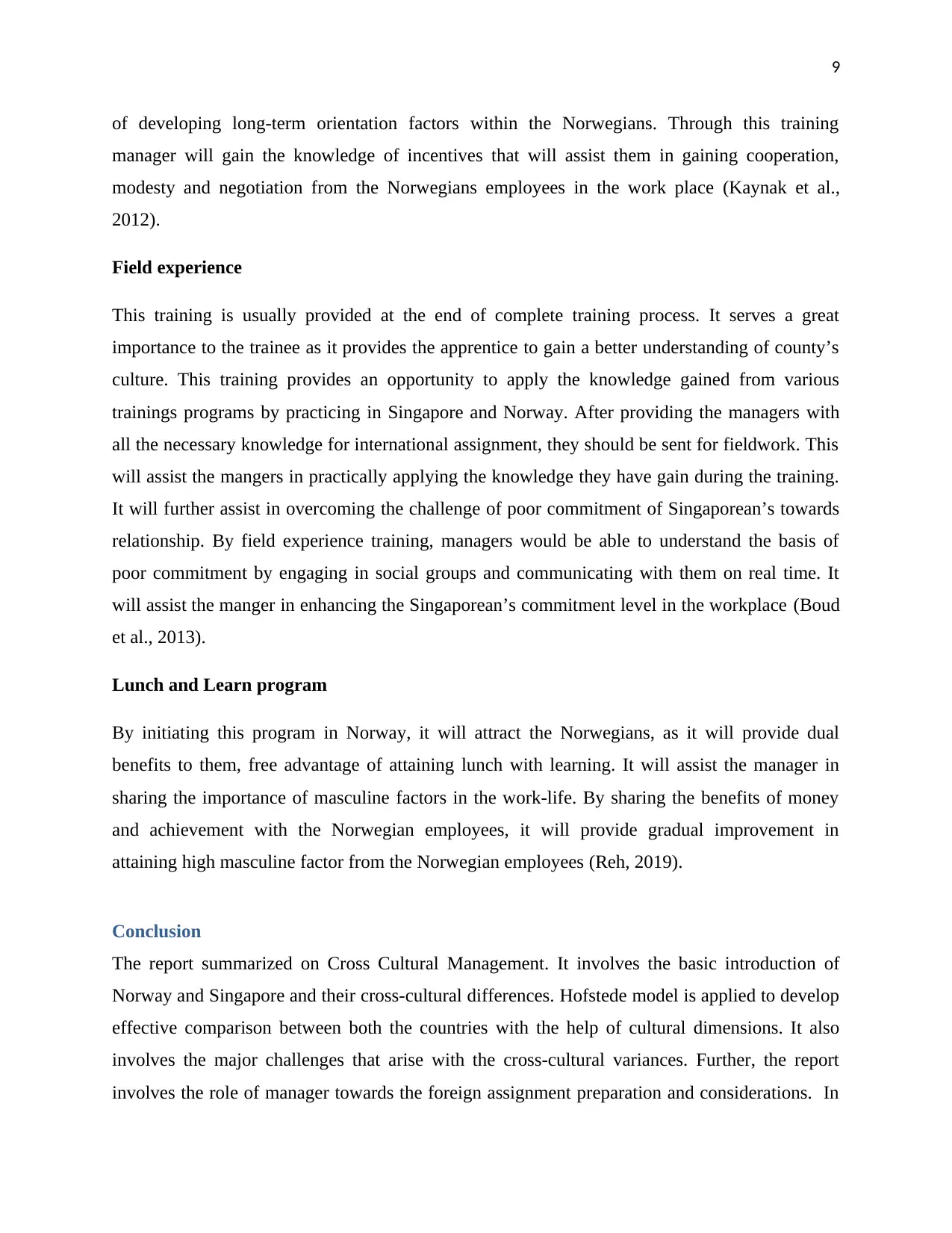
9
of developing long-term orientation factors within the Norwegians. Through this training
manager will gain the knowledge of incentives that will assist them in gaining cooperation,
modesty and negotiation from the Norwegians employees in the work place (Kaynak et al.,
2012).
Field experience
This training is usually provided at the end of complete training process. It serves a great
importance to the trainee as it provides the apprentice to gain a better understanding of county’s
culture. This training provides an opportunity to apply the knowledge gained from various
trainings programs by practicing in Singapore and Norway. After providing the managers with
all the necessary knowledge for international assignment, they should be sent for fieldwork. This
will assist the mangers in practically applying the knowledge they have gain during the training.
It will further assist in overcoming the challenge of poor commitment of Singaporean’s towards
relationship. By field experience training, managers would be able to understand the basis of
poor commitment by engaging in social groups and communicating with them on real time. It
will assist the manger in enhancing the Singaporean’s commitment level in the workplace (Boud
et al., 2013).
Lunch and Learn program
By initiating this program in Norway, it will attract the Norwegians, as it will provide dual
benefits to them, free advantage of attaining lunch with learning. It will assist the manager in
sharing the importance of masculine factors in the work-life. By sharing the benefits of money
and achievement with the Norwegian employees, it will provide gradual improvement in
attaining high masculine factor from the Norwegian employees (Reh, 2019).
Conclusion
The report summarized on Cross Cultural Management. It involves the basic introduction of
Norway and Singapore and their cross-cultural differences. Hofstede model is applied to develop
effective comparison between both the countries with the help of cultural dimensions. It also
involves the major challenges that arise with the cross-cultural variances. Further, the report
involves the role of manager towards the foreign assignment preparation and considerations. In
of developing long-term orientation factors within the Norwegians. Through this training
manager will gain the knowledge of incentives that will assist them in gaining cooperation,
modesty and negotiation from the Norwegians employees in the work place (Kaynak et al.,
2012).
Field experience
This training is usually provided at the end of complete training process. It serves a great
importance to the trainee as it provides the apprentice to gain a better understanding of county’s
culture. This training provides an opportunity to apply the knowledge gained from various
trainings programs by practicing in Singapore and Norway. After providing the managers with
all the necessary knowledge for international assignment, they should be sent for fieldwork. This
will assist the mangers in practically applying the knowledge they have gain during the training.
It will further assist in overcoming the challenge of poor commitment of Singaporean’s towards
relationship. By field experience training, managers would be able to understand the basis of
poor commitment by engaging in social groups and communicating with them on real time. It
will assist the manger in enhancing the Singaporean’s commitment level in the workplace (Boud
et al., 2013).
Lunch and Learn program
By initiating this program in Norway, it will attract the Norwegians, as it will provide dual
benefits to them, free advantage of attaining lunch with learning. It will assist the manager in
sharing the importance of masculine factors in the work-life. By sharing the benefits of money
and achievement with the Norwegian employees, it will provide gradual improvement in
attaining high masculine factor from the Norwegian employees (Reh, 2019).
Conclusion
The report summarized on Cross Cultural Management. It involves the basic introduction of
Norway and Singapore and their cross-cultural differences. Hofstede model is applied to develop
effective comparison between both the countries with the help of cultural dimensions. It also
involves the major challenges that arise with the cross-cultural variances. Further, the report
involves the role of manager towards the foreign assignment preparation and considerations. In
Paraphrase This Document
Need a fresh take? Get an instant paraphrase of this document with our AI Paraphraser
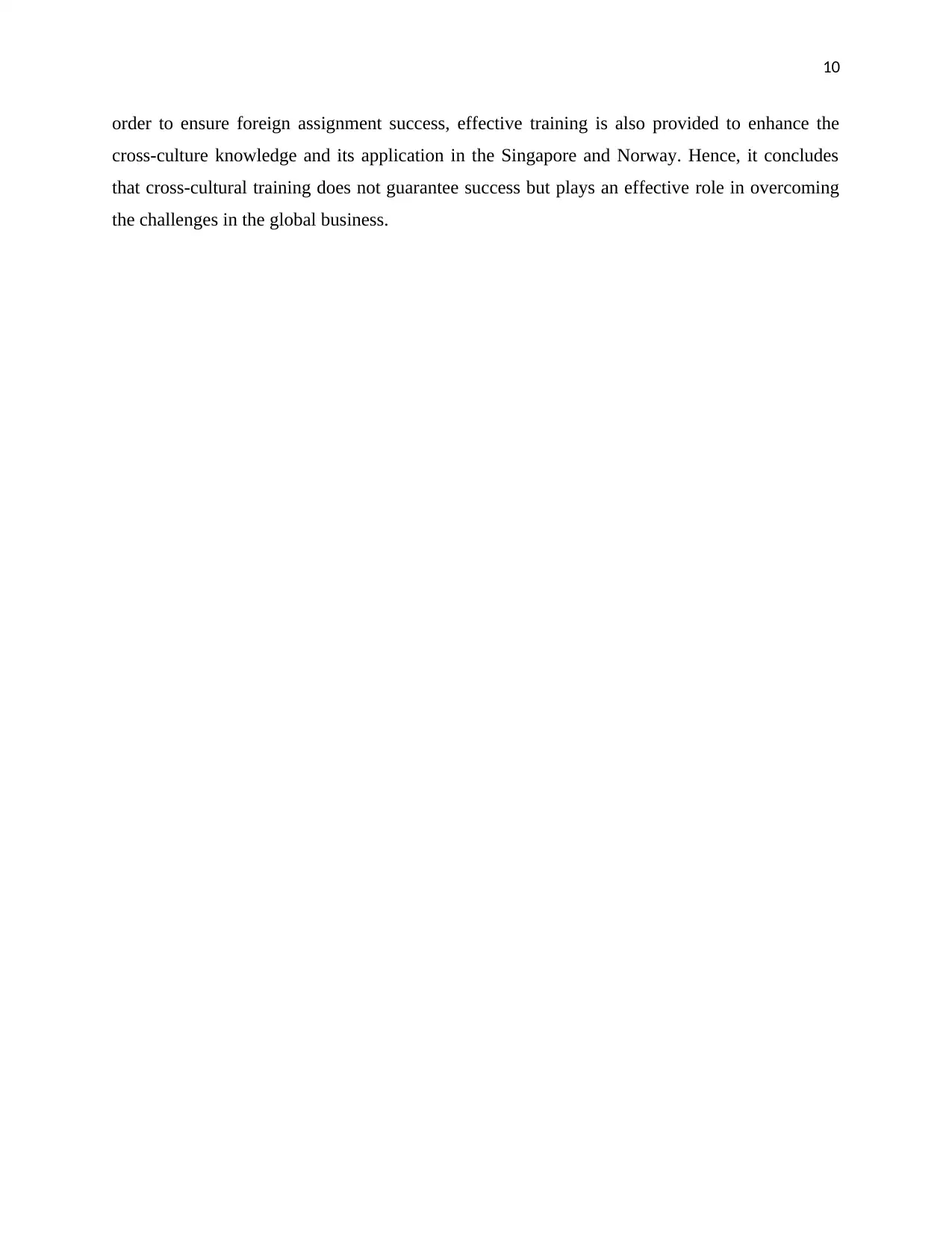
10
order to ensure foreign assignment success, effective training is also provided to enhance the
cross-culture knowledge and its application in the Singapore and Norway. Hence, it concludes
that cross-cultural training does not guarantee success but plays an effective role in overcoming
the challenges in the global business.
order to ensure foreign assignment success, effective training is also provided to enhance the
cross-culture knowledge and its application in the Singapore and Norway. Hence, it concludes
that cross-cultural training does not guarantee success but plays an effective role in overcoming
the challenges in the global business.
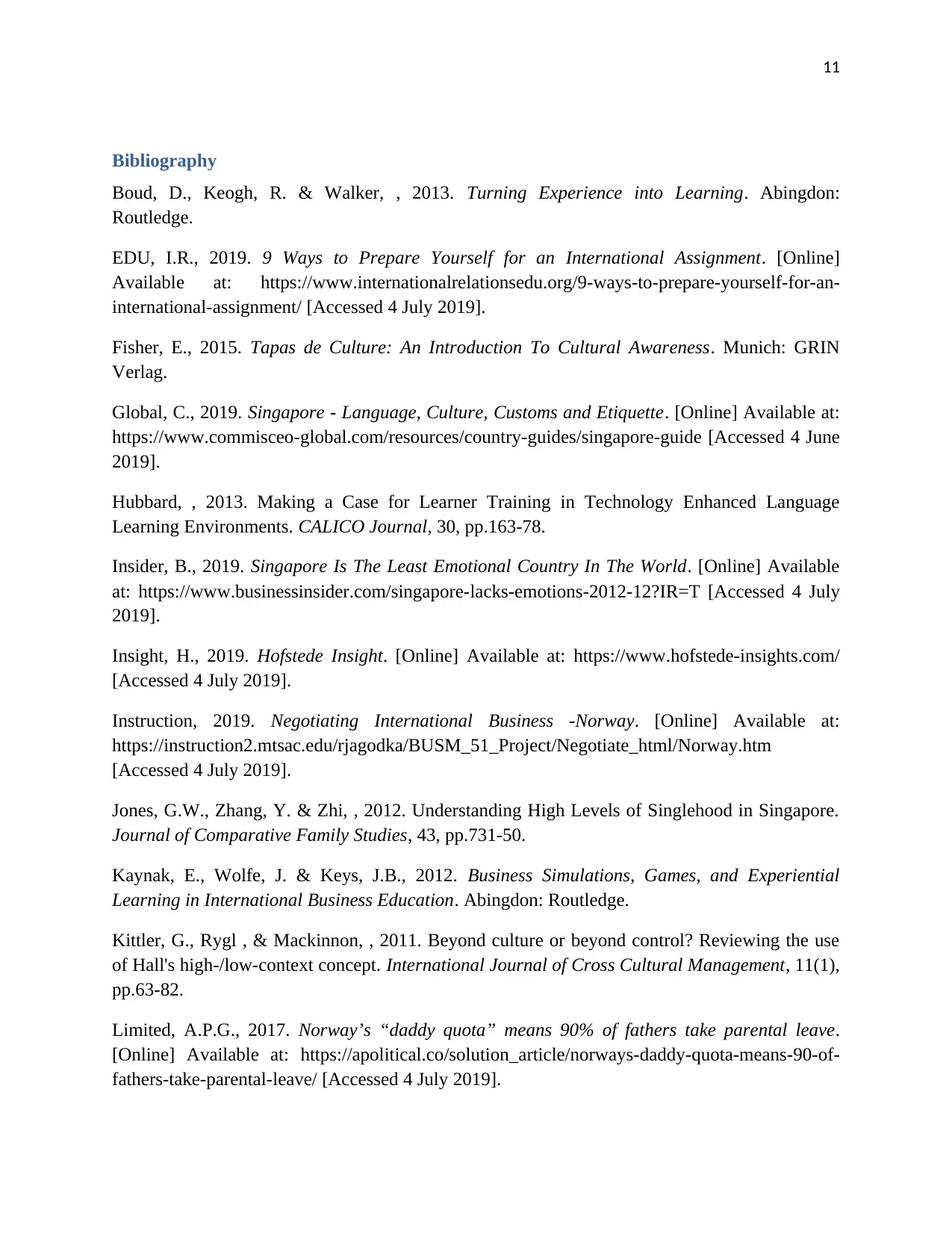
11
Bibliography
Boud, D., Keogh, R. & Walker, , 2013. Turning Experience into Learning. Abingdon:
Routledge.
EDU, I.R., 2019. 9 Ways to Prepare Yourself for an International Assignment. [Online]
Available at: https://www.internationalrelationsedu.org/9-ways-to-prepare-yourself-for-an-
international-assignment/ [Accessed 4 July 2019].
Fisher, E., 2015. Tapas de Culture: An Introduction To Cultural Awareness. Munich: GRIN
Verlag.
Global, C., 2019. Singapore - Language, Culture, Customs and Etiquette. [Online] Available at:
https://www.commisceo-global.com/resources/country-guides/singapore-guide [Accessed 4 June
2019].
Hubbard, , 2013. Making a Case for Learner Training in Technology Enhanced Language
Learning Environments. CALICO Journal, 30, pp.163-78.
Insider, B., 2019. Singapore Is The Least Emotional Country In The World. [Online] Available
at: https://www.businessinsider.com/singapore-lacks-emotions-2012-12?IR=T [Accessed 4 July
2019].
Insight, H., 2019. Hofstede Insight. [Online] Available at: https://www.hofstede-insights.com/
[Accessed 4 July 2019].
Instruction, 2019. Negotiating International Business -Norway. [Online] Available at:
https://instruction2.mtsac.edu/rjagodka/BUSM_51_Project/Negotiate_html/Norway.htm
[Accessed 4 July 2019].
Jones, G.W., Zhang, Y. & Zhi, , 2012. Understanding High Levels of Singlehood in Singapore.
Journal of Comparative Family Studies, 43, pp.731-50.
Kaynak, E., Wolfe, J. & Keys, J.B., 2012. Business Simulations, Games, and Experiential
Learning in International Business Education. Abingdon: Routledge.
Kittler, G., Rygl , & Mackinnon, , 2011. Beyond culture or beyond control? Reviewing the use
of Hall's high-/low-context concept. International Journal of Cross Cultural Management, 11(1),
pp.63-82.
Limited, A.P.G., 2017. Norway’s “daddy quota” means 90% of fathers take parental leave.
[Online] Available at: https://apolitical.co/solution_article/norways-daddy-quota-means-90-of-
fathers-take-parental-leave/ [Accessed 4 July 2019].
Bibliography
Boud, D., Keogh, R. & Walker, , 2013. Turning Experience into Learning. Abingdon:
Routledge.
EDU, I.R., 2019. 9 Ways to Prepare Yourself for an International Assignment. [Online]
Available at: https://www.internationalrelationsedu.org/9-ways-to-prepare-yourself-for-an-
international-assignment/ [Accessed 4 July 2019].
Fisher, E., 2015. Tapas de Culture: An Introduction To Cultural Awareness. Munich: GRIN
Verlag.
Global, C., 2019. Singapore - Language, Culture, Customs and Etiquette. [Online] Available at:
https://www.commisceo-global.com/resources/country-guides/singapore-guide [Accessed 4 June
2019].
Hubbard, , 2013. Making a Case for Learner Training in Technology Enhanced Language
Learning Environments. CALICO Journal, 30, pp.163-78.
Insider, B., 2019. Singapore Is The Least Emotional Country In The World. [Online] Available
at: https://www.businessinsider.com/singapore-lacks-emotions-2012-12?IR=T [Accessed 4 July
2019].
Insight, H., 2019. Hofstede Insight. [Online] Available at: https://www.hofstede-insights.com/
[Accessed 4 July 2019].
Instruction, 2019. Negotiating International Business -Norway. [Online] Available at:
https://instruction2.mtsac.edu/rjagodka/BUSM_51_Project/Negotiate_html/Norway.htm
[Accessed 4 July 2019].
Jones, G.W., Zhang, Y. & Zhi, , 2012. Understanding High Levels of Singlehood in Singapore.
Journal of Comparative Family Studies, 43, pp.731-50.
Kaynak, E., Wolfe, J. & Keys, J.B., 2012. Business Simulations, Games, and Experiential
Learning in International Business Education. Abingdon: Routledge.
Kittler, G., Rygl , & Mackinnon, , 2011. Beyond culture or beyond control? Reviewing the use
of Hall's high-/low-context concept. International Journal of Cross Cultural Management, 11(1),
pp.63-82.
Limited, A.P.G., 2017. Norway’s “daddy quota” means 90% of fathers take parental leave.
[Online] Available at: https://apolitical.co/solution_article/norways-daddy-quota-means-90-of-
fathers-take-parental-leave/ [Accessed 4 July 2019].
⊘ This is a preview!⊘
Do you want full access?
Subscribe today to unlock all pages.

Trusted by 1+ million students worldwide
1 out of 13
Related Documents
Your All-in-One AI-Powered Toolkit for Academic Success.
+13062052269
info@desklib.com
Available 24*7 on WhatsApp / Email
![[object Object]](/_next/static/media/star-bottom.7253800d.svg)
Unlock your academic potential
Copyright © 2020–2025 A2Z Services. All Rights Reserved. Developed and managed by ZUCOL.




